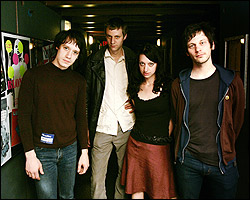ARTISTRY HIDES ITSELF in the crudest packages, giving only the slightest clue that something beautiful might be inside. For those who harness it and those who document it, the challenge is first to recognize it. History is a rail-thin poet with an acoustic guitar, five friends from Liverpool, and a Southern boy with deviant hips. But before history becomes History, those things are just loosely placed bets, dreams about independence, high hopes.
artist to icon
Experience Music Project ends May 1
Experience Music Project’s new photography exhibition, “Artist to Icon: Early Photographs of Elvis, Dylan and the Beatles,” currently on display in the Special Exhibit Gallery at the museum, catalogs the lives of these legends before they were legendary, when they were merely men, even boys. The images are the work of Alfred Wertheimer, Astrid Kirchherr, Jurgen Vollmer, Max Scheler, and Daniel Kramer. Each of these photographers had access to the artists early in their careers, and the work illustrates the precelebrity journey of these cultural institutions. The collection includes 48 rarely seen black-and-white photographs.
Kirchherr and Vollmer photographed the Beatles in Hamburg, Germany, from 1960 to 1962. Scheler later joined Kirchherr and the band in England in 1964. It’s nearly impossible to view the Hamburg photographs, which feature early members Pete Best and Stuart Sutcliffe, without the handicap of hindsight. Among the most striking is a pair of portraits, one of Paul McCartney and one of John Lennon. The two Beatles are framed identically; each is posed stoically, in the foreground of the shot. In the background, Stuart Sutcliffe looms as a blur, a ghostly apparition. At first inspection, the two songwriters appear boyish and unaware. But as the observer sheds that romantic notion, it’s clear that Lennon and McCartney were already filled with cockiness and assured pride.
Similarly, a stunning portrait of Bob Dylan commands the center of the gallery. The 39-inch by 55-inch photograph was taken in 1965 by Daniel Kramer and was selected by Dylan, 20 years later, to appear on the jacket of his retrospective collection, Biograph. Dylan, his disheveled, dirty hair perfectly undone, is conspicuously frozen in time. His eyes skirting the camera and his determined gaze narrowing just slightly, he’s forever stuck in that moment of shutter and advance. If he didn’t know for sure that he would soon be likened to Shelley, that he would inspire a musical revolution, it seems that he had a pretty good inclination.
I SPOKE TO DANIEL KRAMER at the museum’s pre-opening reception last Thursday. As a young photographer intent on building his portfolio, Kramer—who says he knew nothing about folk music at the time—saw the young songwriter on a television show and was struck by Dylan’s politically challenging lyrics and his rambling, poetic use of language. The music, he says, was merely interesting. This turns out to be a perfect metaphor for the exhibition: As much as Kramer talks about Dylan’s legacy, he asserts that “Artist to Icon” is about the incredible language of photography, not just the music of the cameras’ subjects.
As the relationship between Kramer and Dylan grew, so did the photographer’s appreciation for Dylan’s music. Kramer accompanied Dylan to various performances around the country and began to understand that what he was photographing was extraordinary. As Dylan experimented with electric guitars, Kramer watched with rapt attention. His images tell the story; Kramer combines a historian’s eye for detail and a storyteller’s love of drama.
Kramer wasn’t completely cognizant of Dylan’s impact, but today many consider Kramer’s long out-of-print photographic study, Bob Dylan, to be a definitive example of capturing a young artist’s genesis into an icon.
“I thought I was doing good; I thought I was making good pictures. I knew that he was a very important writer. I knew it was good and I was very excited—but how do you predict?” Kramer asks.
It’s easy, in this world of quick stardom, to stand before a photograph of a young Elvis—the strikingly handsome man who delivered the black man’s blues to white America and called it rock and roll—and believe that anticipating greatness is immediate and simple. But these images remind us of the caterpillar and the butterfly. They remind us that before history is written, lives transform—often in front of our eyes.








